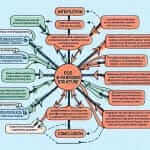As an IELTS instructor with over two decades of experience, I often encounter students who feel overwhelmed by the IELTS Listening test. One common concern is understanding the structure and content of each section. This comprehensive guide will delve into the intricacies of each section in the IELTS Listening test, equipping you with the knowledge and strategies to excel.
Understanding the IELTS Listening Test Format
The IELTS Listening test is the same for both IELTS Academic and IELTS General Training. It is divided into four sections, each with 10 questions, making a total of 40 questions. You will have 30 minutes to complete the listening test, plus an additional 10 minutes to transfer your answers to the answer sheet.
Deconstructing Each Section: Content and Strategies
Section 1: Social Interactions
This section usually involves a conversation between two speakers in an everyday social context, such as making a booking, inquiring about a course, or discussing travel plans.
Key Features:
- Focus on factual information: You will be required to listen for specific details like names, dates, times, and places.
- Dialogue format: Familiarize yourself with common conversational phrases and expressions.
Strategies:
- Predict before you listen: Look at the questions and try to anticipate what kind of information you need to listen for.
- Focus on keywords: Identify key words in both the questions and the audio that signal important information.
Section 2: Monologue or Guided Talk
This section typically features a monologue or a guided talk on a general topic. This could be a speech, a presentation, a radio broadcast, or a tour guide’s commentary.
Key Features:
- Informational content: The focus is on understanding the main ideas, key points, and supporting details of the talk.
- Single speaker: This section tests your ability to follow a longer discourse from one speaker.
Strategies:
- Identify the topic and purpose: Pay attention to the introduction to understand the overall theme and the speaker’s objective.
- Listen for signposting language: Speakers often use phrases like “Firstly,” “Next,” “In addition,” to signal different points.
Section 3: Educational or Training Context
This section involves a conversation between two to four people in an academic setting, such as a student tutorial, a group project discussion, or a lecture excerpt.
Key Features:
- Academic vocabulary and concepts: Be prepared to encounter subject-specific terminology and complex sentence structures.
- Multiple speakers: Pay attention to the different perspectives and contributions of each speaker.
Strategies:
- Note-taking: Develop a system for jotting down key points and names as you listen.
- Focus on speaker roles and opinions: Be aware of who is speaking and their stance on the topic.
Section 4: Academic Lecture
The final section features a monologue on an academic topic, similar to a university lecture. The speaker might be discussing a scientific theory, historical event, or literary work.
Key Features:
- Conceptual and detailed: This section challenges your ability to comprehend abstract ideas and follow complex arguments.
- Formal language: Be prepared for academic vocabulary, complex grammar, and a faster pace of speech.
Strategies:
- Skim the questions: Quickly glance at the questions to anticipate the focus of the lecture.
- Listen for definitions and examples: Speakers often define key terms and provide examples to illustrate their points.
 ielts listening practice
ielts listening practice
Tips for Success
- Practice Regularly: Familiarize yourself with the test format by listening to practice tests and analyzing your strengths and weaknesses.
- Develop Your Vocabulary: Expand your academic vocabulary by reading widely on various topics.
- Improve Your Note-Taking Skills: Practice taking concise and effective notes while listening to lectures or podcasts.
- Stay Calm and Focused: Avoid getting distracted during the test and stay focused on the task at hand.
Conclusion
Mastering the IELTS Listening test requires understanding the nuances of each section and applying effective listening strategies. By consistently practicing and honing your skills, you can approach the listening test with confidence and achieve your desired band score. Remember, the key to success lies in focused preparation and a strategic approach. Good luck!


